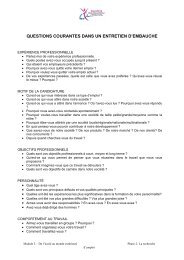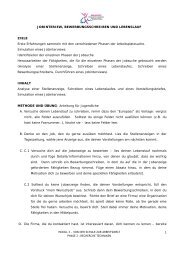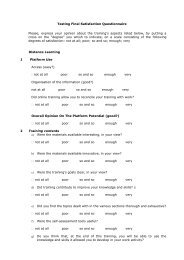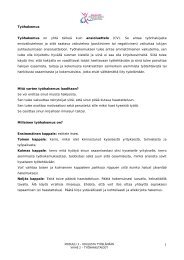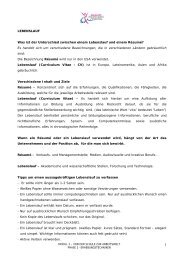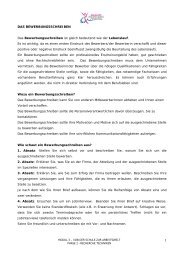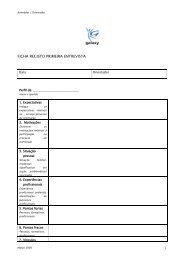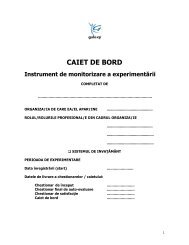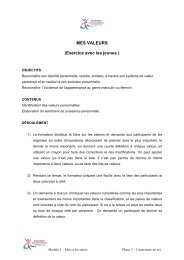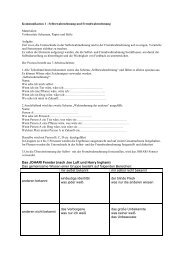METHODOLOGICAL NOTE - Galaxies
METHODOLOGICAL NOTE - Galaxies
METHODOLOGICAL NOTE - Galaxies
You also want an ePaper? Increase the reach of your titles
YUMPU automatically turns print PDFs into web optimized ePapers that Google loves.
GALAXY – Gender Guidance for<br />
Employment choices: pathways<br />
against sexism for equality<br />
Project n. I/06/B/F/PP-154171<br />
<strong>METHODOLOGICAL</strong> <strong>NOTE</strong><br />
GUIDANCE COMPETENCES IN A GENDER PERSPECTIVE<br />
The methodology in the elaboration of the Competence Units<br />
The elaboration of the Competence Units (CU) has been based on the elaboration of three elements:<br />
1. the description of the guidance counsellor’s professional figure, just as it emerges from the research<br />
work. In the absence of a system of certification of the guidance counsellor’s competences the<br />
“knowledge” and the “doing” of the operators working in each partner country have been compared,<br />
these two analysed elements combine in the practical actions and in the specific situations where<br />
guidance counsellors are operating;<br />
2. the suggestions of the possible improvement areas pointed out by the analysis of the final clients’<br />
needs;<br />
3. some criticality areas recurring in the definition of guidance paths:<br />
a. “weakness” and subjective stereotypes (in training choices and work paths, at the access<br />
and in career development, particularly in some life phases, scarce enhancement of personal<br />
and professional resources)<br />
b. “weakness” and objective bounds (socio-cultural stereotypes hindering women’s access to<br />
labour market).<br />
Every Competence Unit (CU), broadly described in this Report, includes a Training Unit (TU) that is<br />
described by the Competences (C) and by the Evaluation Criteria (EC) linked to the transferred<br />
competences. The Evaluation Criteria introduce the path of recognition and certification of the competences.<br />
This articulation is essential in order to pass from no formal to formal learning. This allows, in fact, to have a<br />
common referent for the integration of different vocational training supplies and lifelong learning<br />
capitalization and development.<br />
The Training Modules (TM) proposed by this Report integrate the competences guidance counsellors<br />
already possess, developing the gender reading as transverse element for carrying out a guidance process in<br />
the two systems (education and training / work) accurately.
COMPETENCE UNIT 1<br />
Management and adjustment of educational guidance paths with a gender perspective.<br />
General description of the competence<br />
To manage guidance interventions inside school paths following the educational programming objectives,<br />
introducing elements of reflection on gender differences.<br />
To inform the territorial guidance services about the carried out activities for a collaboration assuring<br />
continuity in respect of students’ development in the social and work environment.<br />
Involved professional<br />
A school teacher committed to accompanying activities, an external professional working with territorial<br />
guidance Centres.<br />
Work area: junior and high schools.<br />
Target: 12 year-old and older students in educational paths<br />
TRAINING UNIT 1<br />
Management and adjustment of educational guidance paths in a gender perspective.<br />
The TU articulation in competences:<br />
C1 - Definition of what a guidance process is, when it is targeted at young people and takes<br />
gender differences into account inside educational learning paths.<br />
C1.1. To identify the elements characterizing an educational guidance process in a gender<br />
perspective, starting from participants’ real experiences;<br />
C.1.2. To identify the elements characterizing an educational guidance process in a gender<br />
perspective, starting from participants’ needs<br />
C2 - Management and adjustment of guidance processes based on the gender-oriented CORA<br />
methodology:<br />
C2.1. To elaborate of personal past experiences and to make explicit the social representations<br />
related to gender (reading of the stereotypes);<br />
C2.2. To develop methodological competences aimed at the analysis of the school environment and at<br />
the identification of actions targeted at the definition of individualized choice paths taking<br />
gender differences into account;<br />
C2.3. To be able to read the different elements (normative, organizational, cultural, social,<br />
institutional) helping to improve or to hinder equal opportunities concept;<br />
2
C2.4. To elaborate some educational tools (videos, hypertexts, CDs,...) that could support didactics to<br />
improve young people’s development in overcoming gender stereotypes<br />
C2.5. To elaborate coping strategies aimed at facing the difficulties emerging in the management of<br />
relations among the students themselves and between teachers and students);<br />
C2.6. To analyse the critical points in order to carry out a guidance process in a gender perspective.<br />
C3 – Development of the guidance process in a gender perspective in the wider landscape of<br />
the training and labour policies carried out in the reference territory:<br />
C3.1. To be able to read the different guidance practices carried out in the territory (how guidance<br />
supply, and in particular guidance supply for a female target, can be analysed);<br />
C3.2. To manage the relations in the different phases of the guidance process;<br />
C3.3. To define common paths for well identified small groups, particularly on the relation between<br />
women and choices or between women and work..<br />
The evaluation criteria linked to competences:<br />
EC1 – To include the role of guidance in the school paths as support to students’ personal choices<br />
EC1 – To be able to carry out guidance processes starting from cultural, social and work changes<br />
EC 2 – To be able to receive and decode clients’ needs<br />
EC 2 – To be able to diagnose the specific situations and to be able to read the activities already carried out<br />
at school<br />
EC2 – To support students respecting their personal choices, the educational objectives and the existing<br />
ways of relations among students and between students and teachers<br />
EC2 – To be able to manage and to introduce innovations in guidance paths that support choices, taking<br />
cultural and social stereotypes into account<br />
EC2 – To be able to intervene with differentiated techniques that take clients’ gender and specific needs into<br />
account<br />
EC3 – To be able to negotiate with the outside in order to activate a collaboration on a guidance process<br />
going beyond the school ambit<br />
EC3 – To be able to define the tools for supporting students in guidance paths going beyond school (paths<br />
of insertion in VT or paths of work placement)<br />
The Training Modules (TM) of the guidance path in a gender perspective targeted at the<br />
education systems<br />
TM1 Setting guidance as a process targeted at young people inside middle-long educational learning paths:<br />
guidance founding principles in a gender diversity “integrating” reading.<br />
3
- Acquisition of knowledge first elements that characterize the function of educational guidance in a<br />
gender perspective, starting from CORA methodology<br />
- Guidance as process and attention to gender as fundamental variable, crossing the whole CORA<br />
methodology<br />
TM2 Management and adjustment of guidance processes based on CORA: methodology introduction to the<br />
concept of stereotype as element founding the development of guidance processes in educational<br />
paths:<br />
- Knowledge elements of the different methodological families (RW, Advp, autobiographical approach)<br />
that constitute Cora approach in the management of guidance processes in a gender perspective;<br />
- Carrying out of a guidance interview in a gender perspective<br />
- Management of group dynamics inside a guidance path in a gender perspective<br />
- Listening, observation, communication and self-awareness with attention to gender differences<br />
- Coping strategies: the elements introducing attention to gender<br />
TM3 The guide criteria for the realization of a territorial network in support of guidance in a gender<br />
perspective<br />
- Mapping and analysis of the private and public structures working in a perspective of equal<br />
opportunities<br />
- Strategies, negotiations and planning with institutional and formal territorial networks working with<br />
attention to gender differences<br />
- Methods of relation for the activation of territorial networks responsive to equal opportunity themes<br />
COMPETENCE UNIT 2<br />
Management and adjustment of guidance paths in vocational training and work environment<br />
with attention to gender differences.<br />
General description of the competence<br />
Carrying out of guidance interventions inside vocational training paths (first and lifelong training) and of<br />
work placement paths following participants’ aspirations and labour market requirements, introducing<br />
elements of reflection on the gender diversities.<br />
To collaborate with the educational systems through information for programming together work placement<br />
and re-insertion paths bringing women near the Labour Market (LM).<br />
4
Involved professional<br />
Vocational training teacher committed to accompanying activities, operator of the Job Centres/territorial<br />
services, guidance counsellor.<br />
Work area<br />
Vocational training Centres, Job Centres, territorial guidance Centres.<br />
Target<br />
Young people, employed, unemployed adult women and men in work placement and/or in vocational<br />
training<br />
TRAINING UNIT 2<br />
Management and adjustment of guidance paths in a gender perspective in vocational<br />
training/work environment<br />
The TU articulation in competences:<br />
C1 - Definition of what a guidance process is when it is targeted at differentiated clients and<br />
takes gender perspective into account inside vocational training and work placement<br />
paths:<br />
C1.1. Identification of the elements characterizing a guidance to choice process in a gender<br />
perspective, starting from participants’ real experiences;<br />
C.1.2. Identification of the elements characterizing a guidance to choice process in a gender<br />
perspective, starting from participants’ needs<br />
C2 – Management and adjustment of guidance processes based on the gender oriented CORA<br />
methodology:<br />
C2.1. To elaborate personal past experiences and to make explicit social and work representations<br />
related to gender (reading of the stereotypes);<br />
C2.2. To develop methodological competences aimed at the analysis of the working environment and<br />
at the identification of actions aimed at the definition of choice individualized paths taking<br />
gender differences into account, at the analysis of the critical elements connected with entering<br />
the labour market<br />
C2.3. To be able to read the different elements (normative, organizational, cultural, social,<br />
institutional) helping to improve or to hinder equal opportunity concept;<br />
C2.4. To structure individual interviews (counselling) and skill assessment paths for the reading and<br />
re-reading of some dimensions founding women’s social and professional identity in general, of<br />
one’s own social and professional identity, of the different subjective variables (already acquired<br />
5
esources, already verified capabilities, already explored interest areas) that can support the<br />
definition / re-definition of choices in the different phases of individual, training, work life;<br />
C2.5. To analyse the critical points for managing a guidance process in a gender perspective<br />
C2.6. To analyse the labour active policies favouring women’s access to and staying in the labour<br />
market<br />
C3 – Development of the guidance process in a gender perspective in the wider landscape of<br />
the training and labour policies carried out in the reference territory:<br />
C3.1. To be able to read the different guidance practices carried out on the territory (how guidance<br />
supply, and in particular guidance supply for a female target, can be analysed);<br />
C3.2. To manage the relations in the different phases of the guidance process;<br />
C3.3. To define common paths for well identified small groups, particularly on the relation between<br />
women and choice, women and work<br />
The evaluation criteria (EC) linked to competences:<br />
EC1 – To include the role of guidance in the training and work placement paths as support to personal<br />
choices, in a gender perspective, for the professional development and the placement in the labour<br />
market<br />
EC1 – To be able to carry out guidance processes starting from the cultural, social and work changes,<br />
connected with the sexual identity<br />
EC2 – To be able to receive and decode clients’ needs according to different social and territorial contexts<br />
EC2 – To be able to diagnose the specific situations and to be able to insert the interventions in the training<br />
and work placement paths<br />
EC2 – To support women respecting their personal choices, the training objectives and the professional<br />
ones<br />
EC2 – To be able to manage, plan and introduce innovations in guidance and in skill assessment paths<br />
supporting choices through the analysis of cultural and social stereotypes<br />
EC2 – To be able to intervene with differentiated techniques that take clients’ gender and specific needs into<br />
account<br />
EC3 – To be able to negotiate with the outside in order to activate a collaboration on a guidance process<br />
going beyond the training environment<br />
EC3 – To support subjects in guidance paths reaching the definition of work placement plans<br />
The Training Modules of the path targeted at the Vocational Training and at the Labour systems<br />
TM1 Setting guidance as a process targeted at differentiated clients: guidance founding principles in a<br />
gender diversity “integrating” reading.<br />
6
- Acquisition of knowledge first elements that characterize the function of guidance to choice in a<br />
gender perspective, starting from CORA methodology<br />
- Guidance as process and attention to gender as fundamental variable, crossing the whole CORA<br />
methodology<br />
TM2 Management and adjustment of guidance processes based on CORA: methodology introduction to the<br />
concept of stereotype as element founding the development of guidance processes in vocational<br />
training and work placement paths:<br />
- Knowledge elements of the different methodological families (Retravailler-to return to work, Advp,<br />
autobiographical approach) that constitute Cora approach in the management of guidance<br />
processes in a gender perspective;<br />
- Carrying it out of the Individual interview in a gender perspective<br />
- Empowerment: the elements introducing attention to gender<br />
- Skill assessment in a gender perspective<br />
- Listening, observation, communication and self-awareness with attention to gender differences<br />
TM3 The guide criteria for the realization of a territorial network in support of guidance in a gender<br />
perspective<br />
- Mapping and analysis of the private and public structures working in a perspective of equal<br />
opportunities<br />
- Strategies, negotiations and planning with institutional and formal territorial networks with gender<br />
perspective<br />
- Methods of relation for the activation of territorial networks responsive to equal opportunity<br />
themes<br />
7



